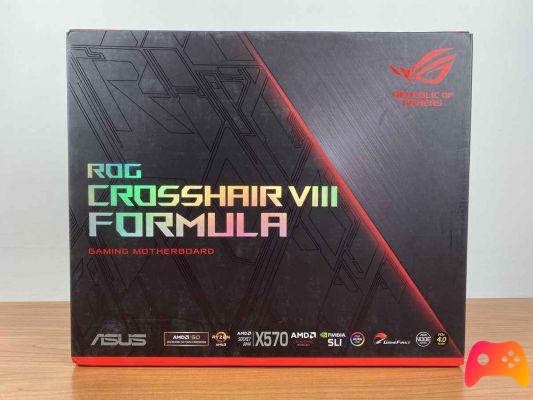
With the advent of the new Ryzen CPUs, AMD has regained a significant slice of the market, narrowing the huge gap that previously existed with respect to its direct competitor, Intel. Witness to this fact are also motherboard manufacturers, who have invested a lot of resources to create a wide range of products able to meet the needs of any type of user.
Asus is one of the manufacturers who believed in the relaunch of AMD and on balance has presented several product lines, both for the consumer market and for the enthusiast one. Its flagship motherboard is ASUS ROG Crosshair VIII Formula, and we're here to tell you about it today.
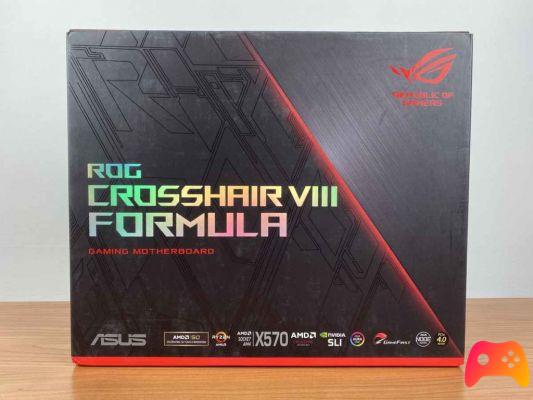
The packaging is the same as for every single ROG product: the predominant colors are black and red. The opening, as we have already seen in other reviews, is a casket, as if we were in the presence of a precious object.
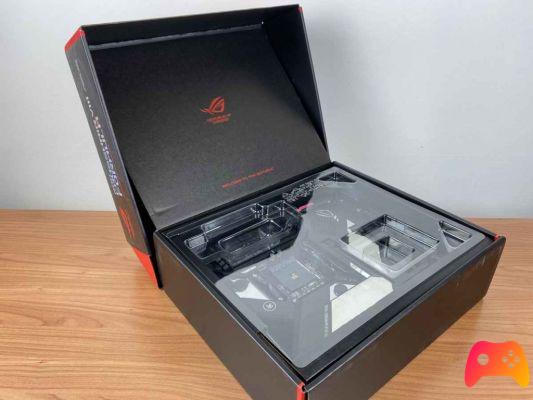
If you have to ask the big question, you can take this motherboard instead of a trivial jewel. On the front we find the name of the product, an image of it and obviously the inevitable and iconic ROG eye in red color.

At the back, all the main features of the product are breached, such as support for third-generation Ryzen processors, the presence of PCI Express 4.0, the maximum amount of installable RAM and the maximum frequency, all this to help the buyer in the best possible way during the purchase phase.

The bundle, like that of all ROG products, is extremely complete and has everything you need, perhaps even more. In addition to Asus ROG Crosshair VIII Formula we find:
- 6 Sata 6 Gb / s cables;
- Wi-Fi antenna;
- Extension cable for RGB LEDs;
- Extension cable for ARGB LED;
- ROG designer coaster;
- Sticker;
- Instruction manual;
- DVD containing the drivers.

If you have already seen the counterpart for Intel, or Asus ROG Maximus XI Formula, you will notice that the design is quite similar, apart from a few small differences. At the heart of Asus ROG Crosshair VIII Formula we obviously find the Socket AM4 but here we don't have the pins, because they are present in the CPU and not in the motherboard.

To the right of it we find the four DDR4 RAM memory slots capable of supporting up to 128GB of memory at 4600Mhz overclocking speed. Next to the RAM slots we find the Start and Reset button, so you can start our system even without the aid of the physical buttons inside the case. Above the socket there are four PWM connectors to manage the fans and a header to connect the ARGB type LEDs, obviously compatible with Aura Sync technology.

Here we also find two connectors for the CPU power supply, one with 4 PIN and one with 8 PIN. The socket is surrounded by 16 phases, which are managed by 16 mosfets.
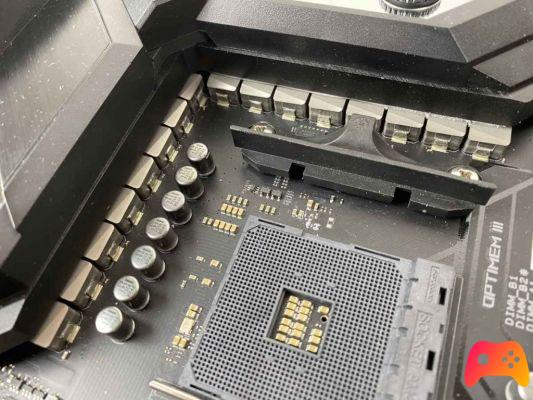
Their cooling is managed by a huge copper heatsink, which supports liquid cooling, should we want to push our CPU beyond all limits. It is a real waterblock developed in collaboration with EK, which goes well with the typical design of the latest ROG motherboards.

Next to the water block we find a plastic cover, which will completely blend in with the cooling block, equipped with a mirror paint with RGB lighting. The visual impact is extremely beautiful to look at, but it is also very delicate: we will have to be extremely careful when cleaning our system, because it will be easily prone to scratches.

Below the socket we find 3 PCI Express ports with 16X features: the first is reached by 16 lines directly from the CPU, while the second by 8 and the last by 4 lines, but it will be managed entirely by the PCH. The first and second slots also have an aluminum reinforcement so as not to flex the video card if it had extremely generous dimensions and weight. Being an enthusiast motherboard, it obviously guarantees support for multi GPU technologies, both from Nvidia and AMD. All three slots are surrounded by a plastic shield, which continues the design of the waterblock, also presenting here a mirror painted plate equipped with RGB LEDs. To the right of the PCIe slots we find another plate, this time in aluminum, where the ROG eye is depicted, obviously illuminated. Below this is the small fan designed to cool the hot spirits of the X570 chipset. Finally, between the third and fourth PCIe slots, we find the heatsink for M.2 drives: once removed we can install up to a maximum of two M.2 drives with size 2280 and NVME support.
Audio management is entrusted to the SupremeFX S1220 multi-channel chipset, positioned at the bottom left as in every motherboard on the market. This chipset, which we have already found in several ROG motherboards in the past, is capable of generating up to 113 dB of noise in and 120 dB out. Asus has used Nichicon Premium capacitors on this motherboard in order to minimize background noise.

At the foot of Asus ROG Crosshair VIII Formula we find the various headers for USB 2.0, for audio and front buttons of the case and for both RGB and ARGB LEDs. On the right side we find 8 Sata 6 Gb / s ports, a header for USB 3.0 and one for USB 3.1. Finally, on the left side we find all the various I / O ports consisting of:
- 8 USB 3.2 Gen 2 (7 type A and one type C);
- 4 USB 3.2 Gen 1 Type A;
- Clear CMOS button;
- BIOS Flashcack button;
- Aquantia 5 Gb / s Ethernet;
- Intel 1 Gb / s Ethernet;
- 2 Intel Wi-Fi 6 antenna connections;
- 5 Gold Plated Audio Jacks;
- 1 SPDIF.

Asus has always spoiled its customers by providing them with a precise, simple and intuitive BIOS that at the same time allows you to manage every single parameter of the installed components. We have two interfaces available, one called EZ Mode, simple and basic where the options are reduced to the bone and one Advanced Mode. In EZ Mode there will be a utility called EZ Turing Wizard, which will apply a slight overclock to our system, all automatically. In Advanced Mode we can instead overclock CPU and RAM manually, looking for the ideal voltage. We will have the ability to change the timing of the RAM, manage the PCI Express ports and each component on board. With the BIOS that we find on board the Asus ROG Crosshair VIII Formula we can do practically anything, and the user friendly interface with the descriptions of each single item will help us to better understand each setting.
And now the most awaited part: the tests. The test configuration is composed as follows:
- Asus ROG Crosshair VIII Formula;
- AMD Ryzen 7 3700X;
- 2 × 8 GB G.Skill TridentZ 4400 Mhz;
- Samsung SSD 970 EVO;
- Nvidia Geforce RTX 2080Ti;
- Asus ROG Thorr 850w;
- Windows 10 Pro 64 Bit.
The CPU was cooled using the NZXT Kraken X52 All in One cooler, while for the GPU we used the stock cooler.
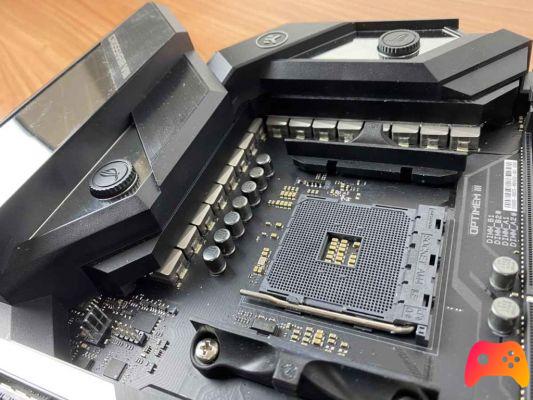
We tested every part of ASUS ROG Crosshair VIII Formula using different synthetic and video game benchmarks. The first test we performed is Cinebench R15, a well-known CPU benchmark that simulates a rendering situation, excellent for testing the power of our processor and checking its stability in an over-clock situation. AMD Ryzen 7 3700X scored a single thread score of 194 CB, while in multi thread it totaled 2058 CB. The second test is Cinebench R20, the latest version of the famous benchmark with Ray tracing support. The pairing has totaled a single thread score of 488 CB, while in multi thread it totaled 4761 CB. For the third test we used V-Ray, a benchmark that simulates a rendering situation, obtaining a score of 12370, a truly amazing result.
We then used 7-Zip, a well-known archive compression and decompression program that uses multi thread. In compression, the combination achieved a score of 48,72 MB / s, while in decompression he got a score of 944,47 MB / s. To test the two 8 GB DDR4 modules of G.Skill 4400 Mhz, we used AIDA 64. Unfortunately we were unable to bring the RAM to their frequency because it was too high and the system often crashed, so we decided to test them at a more stable frequency, that is 3200Mhz. The memories coupled with Asus ROG Crosshair VIII Formula, have totaled in read 89.783 MB / s, write 77.811 MB / s and copy 75.430 MB / s.

Certainly could not miss a test with the well-known 3D Mark suite. We used the Time Spy scenario, which takes advantage of Microsoft's proprietary DirectX 12 libraries. The system scored a Total Score of 12717 points, while the CPU alone scored 8719 points. Finally we tried the combination of AMD Ryzen 7 3700X and Asus ROG Crosshair VIII Formula with video games, to be precise Shadow of the Tomb Raider and Far Cry 5. For Shadow of the Tomb Raider we used the same graphics settings that we use during our reviews of the GPUs, then ultra presets, DirectX 12 active and antialiasing set to TAA. With 1920 x 1080 pixel resolution, we have achieved 153 average FPS, while at 2560 x 1440 resolution we got 107 FPS medi.
Also for Far Cry 5 we used the same graphic settings we use during the other reviews, so ultra presets and active HDR. With a resolution of 1920 x 1080 pixels we obtained an average 81 FPS: a fairly evident bottleneck, in fact the GPU was used for about 60% of its power. On the other hand, at a resolution of 2560 x 1440 pixels, the combination totaled 129 Average FPS, and this makes us understand how evident the bottleneck was in Full HD. Despite this, even in WQHD there is the bottleneck, however, lighter than the 1080p resolution. Asus ROG Crosshair VIII Hero Wi-Fi is a motherboard developed with overclocking in mind: it can also be seen from the high number of phases, 16 only for the CPU.
The VRMs, the component that heats the most in a motherboard, on Asus ROG Crosshair VIII Formula turn out to be extremely cold, thanks to the two supplied heatsinks. Even with the CPU overclocked, the VRMs hit the maximum temperature of 55 °. The PCH, despite the triple consumption compared to the previous version, thanks to the supplied fan did not have particular temperature problems, recording a maximum peak of 60 °.
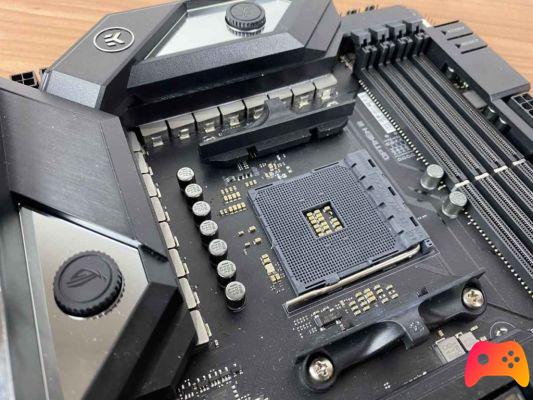
Asus ROG Crosshair VIII Formula represents the top of the range proposal of Asus' ROG family. Extremely robust and solid in every aspect, thanks to the style that fully encompasses the ROG DNA of recent times, the card is extremely beautiful to look at and will match any case in which you go to install it. The heatsink that we find on board manages to keep the VRMs cool and thanks to the integrated waterblock, we can keep them even colder and push our CPU even more. If you want a durable and stable system you can count on this motherboard.
All beautiful things, however, have a considerable price, Asus ROG Crosshair VIII Formula is sold for around € 570 including VAT.
Deprecated: Automatic conversion of false to array is deprecated in /home/epictrick.com/htdocs/php/post.php on line 612






